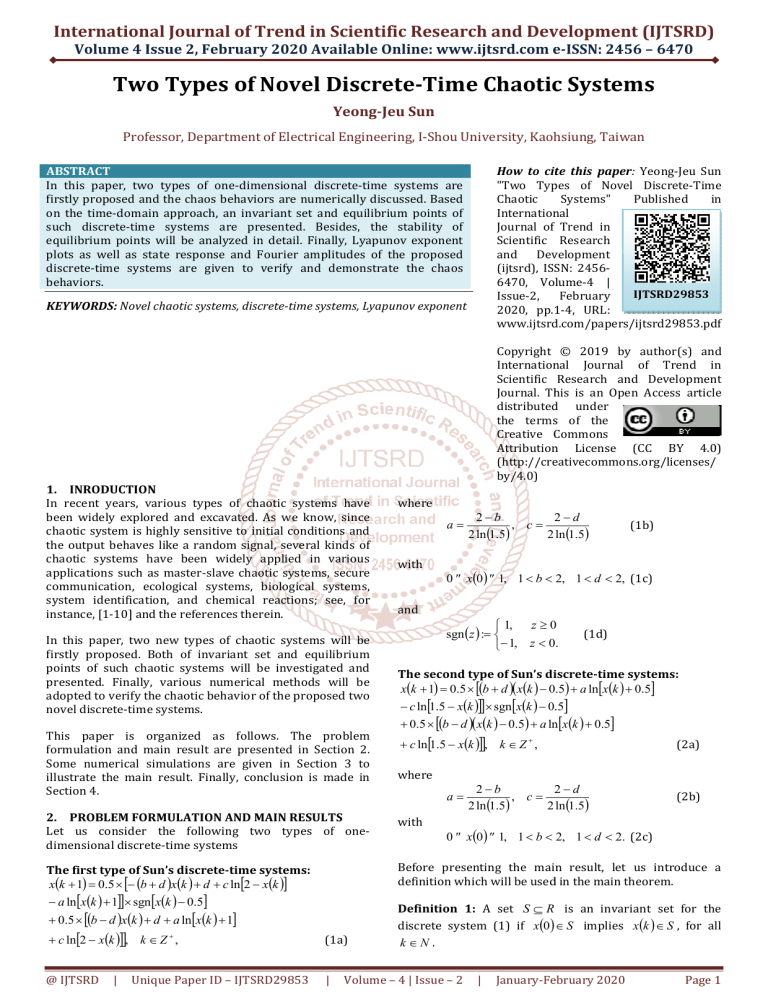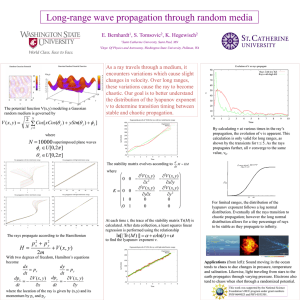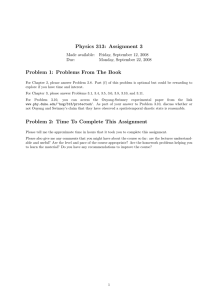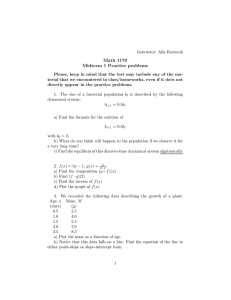
International Journal of Trend in Scientific Research and Development (IJTSRD)
Volume 4 Issue 2, February 2020 Available Online: www.ijtsrd.com e-ISSN:
e
2456 – 6470
Two Types off Novel Discrete-Time
Discrete Time Chaotic Systems
Yeong-Jeu Sun
Professor, Department off Electrical Engineering, I-Shou
I Shou University, Kaohsiung, Taiwan
How to cite this paper:
paper Yeong-Jeu Sun
"Two Types of Novel Discrete-Time
Discrete
Chaotic
Syst
Systems"
Published
in
International
Journal of Trend in
Scientific Research
and Development
(ijtsrd), ISSN: 24562456
6470, Volume-4
Volume
|
IJTSRD29853
Issue-2,
2,
February
2020, pp.1-4,
pp.1
URL:
www.ijtsrd.com/papers/ijtsrd29853.pdf
ABSTRACT
In this paper, two types of one-dimensional
dimensional discrete-time
discrete
systems are
firstly proposed and the chaos behaviors are numerically discussed. Based
on the time-domain
domain approach, an invariant set and equilibrium points of
such discrete-time
time systems are presented. Besides, the stability of
equilibrium points will be analyzed in detail. Finally, Lyapunov
Lyapuno exponent
plots as well as state response and Fourier amplitudes of the proposed
discrete-time
time systems are given to verify and demonstrate the chaos
behaviors.
KEYWORDS: Novel chaotic systems, discrete-time
discrete
systems, Lyapunov exponent
Copyright © 2019 by author(s) and
International Journal of Trend in
Scientific Research and Development
Journal. This is an Open Access article
distributed under
the terms of the
Creative Commons
Attribution License (CC BY 4.0)
(http://creativecommons.org/
http://creativecommons.org/licenses/
by/4.0)
1. INRODUCTION
In recent years, various types of chaotic systems have
been widely explored and excavated. As we know, since
chaotic system is highly sensitive to initial conditions and
the output behaves like a random signal, several kinds of
chaotic systems have been widely applied in various
applications such as master-slave
slave chaotic systems, secure
communication, ecological systems, biological systems,
system identification, and chemical reactions; see, for
instance, [1-10]
10] and the references therein.
In this paper, two new types of chaotic systems will be
firstly proposed. Both of invariant set and equilibrium
points of such chaotic systems will be investigated and
presented. Finally, various numerical methods will be
adopted to verify the chaotic behavior of the proposed two
novel discrete-time systems.
This paper is organized as follows. The problem
formulation and main result are presented in Section 2.
Some numerical simulations are given in Section 3 to
illustrate the main result. Finally, conclusion is made in
Section 4.
where
a=
with
2−b
2−d
, c=
2 ln (1.5)
2 ln (1.5)
(1b)
0 ≤ x(0) ≤ 1, 1 < b < 2, 1 < d < 2, (1c)
and
1, z ≥ 0
sgn (z ) :=
− 1, z < 0.
(1d)
The second type of Sun’s discrete-time
discrete
systems:
x(k + 1) = 0.5 × [(b + d )(x(k ) − 0.5) + a ln[x(k ) + 0.5]
− c ln[1.5 − x(k )]]× sgn[x(k ) − 0.5]
+ 0.5 × [(b − d )( x(k ) − 0.5) + a ln[x(k ) + 0.5]
+ c ln[1.5 − x(k )]], k ∈ Z + ,
where
a=
2−b
2−d
, c=
2 ln (1.5)
2 ln (1.5)
(2a)
(2b)
2. PROBLEM FORMULATION AND MAIN RESULTS
Let us consider the following two types of oneone
dimensional discrete-time systems
with
The first type of Sun’s discrete-time
time systems:
x(k + 1) = 0.5 × [− (b + d )x(k ) + d + c ln[2 − x(k )]
Before presenting the main result, let us introduce a
definition which will be used in the main theorem.
+ c ln[2 − x(k )]], k ∈ Z + ,
(1a)
Definition 1: A set S ⊆ R is an invariant set for the
discrete system (1) if x(0) ∈ S implies x (k ) ∈ S , for all
k∈N .
@ IJTSRD
|
− a ln[x(k ) + 1]]× sgn[x(k ) − 0.5]
+ 0.5 × [(b − d )x(k ) + d + a ln[x(k ) + 1]
|
Unique Paper ID – IJTSRD29
29853
0 ≤ x(0) ≤ 1, 1 < b < 2, 1 < d < 2. (2c)
Volume – 4 | Issue – 2
|
January-February
February 2020
Page 1
International Journal of Trend in Scientific Research and Development (IJTSRD) @ www.ijtsrd.com eISSN: 2456-6470
Now we present the first main result.
Theorem 1: The set of [0,1] is an invariant set for the
discrete systems (1) and (2).
Proof. It is easy to see that if x(k ) ∈ [0,1] implies
x(k + 1) ∈ [0,1], ∀ k ∈ Z + . Consequently, we conclude that if
x(0) ∈ [0,1] implies x(k ) ∈ [0,1], ∀ k ∈ N . This completes the
proof. ϒ
Now we present the second main results.
Theorem 2: The set of equilibrium points of the system
(1) and (2) are given by {0, x} and {0, x̂}, respectively,
where x and x̂ satisfy the following equations
2−d
x = d (1 − x ) +
ln(2 − x ),
2 ln (1.5)
2−d
xˆ = d (0.5 − xˆ ) +
ln (1.5 − xˆ ).
2 ln (1.5)
Furthermore, all of above equilibrium points are unstable.
Proof. (i) (Analysis of the system (1))
Let us define
f (x ) := 0.5 × [− (b + d )x + d + c ln (2 − x )
− a ln (x + 1)]× sgn ( x − 0.5)
+ 0.5 × [(b − d )x + d + a ln( x + 1) + c ln (2 + x )].
From the equation of x = f (x ) , it results that x = 0 and x ,
with
x = d (1 − x ) + c ln (2 − x )
= d (1 − x ) +
2−d
ln (2 − x ).
2 ln(1.5)
In addition, it is easy to see that
3. NUMERICAL SIMULATIONS
Lyapunov exponent plots of the discrete-time systems of
(1), with x(0 ) = 0.25 , is depicted in Figure 1. Time response
of x(k ) and Fourier amplitudes for the nonlinear system
(1), with x(0 ) = 0.25 and (b, d ) = (1.8,1.7 ) , are depicted in
Figure 2 and Figure 3, respectively. Besides, the Lyapunov
exponent plots of the nonlinear systems of (2), with
x(0 ) = 0.35 , is depicted in Figure 4. Time response of x(k )
and Fourier amplitudes for the discrete-time system (2),
with x(0 ) = 0.35 and (b, d ) = (1.6,1.9 ) , are depicted in
Figure 5 and Figure 6, respectively. The simulation graphs
show that both of systems (1) and (2) have chaotic
behavior. This is due to the fact that all of Lyapunov
exponent are larger than one.
4. CONCLUSION
In this paper, two types of Sun’s one-dimensional discretetime systems are firstly proposed and the chaos behaviors
are numerically discussed. Based on the time-domain
approach, an invariant set and equilibrium points of such
discrete-time systems have been presented. Besides, the
stability of equilibrium points has been analyzed in detail.
Finally, Lyapunov exponent plots as well as state response
and Fourier amplitudes for the proposed discrete-time
systems have been given to verify and demonstrate the
chaos behaviors.
ACKNOWLEDGEMENT
The author thanks the Ministry of Science and Technology
of Republic of China for supporting this work under grant
MOST 107-2221-E-214-030. Furthermore, the author is
grateful to Chair Professor Jer-Guang Hsieh for the useful
comments.
This implies that both of equilibrium points 0
(ii) (Analysis of the system (2))
REFERENCES
[1] K. Khettab, S. Ladaci, and Y. Bensafia, “Fuzzy adaptive
control of fractional order chaotic systems with
unknown control gain sign using a fractional order
Nussbaum gain,” IEEE/CAA Journal of Automatica
Sinica, vol. 6, pp. 816-823, 2019.
Let us define
g (x ) := 0.5 × [(b + d )( x − 0.5) + a ln (x + 0.5)
− c ln (1.5 − x )]× sgn (x − 0.5)
[2] H. Liu, Y. Zhang, A. Kadir, Y.u Xu, “Image encryption
using complex hyper chaotic system by injecting
impulse into parameters,” Applied Mathematics and
Computation, vol. 360, pp. 83-93, 2019.
c
< −1 .
f ′(0) = a + b > 1 and f ′( x ) = −d −
2−x
+ 0.5 × [(b − d )(x − 0.5) + a ln (x + 0.5)
+ c ln (1.5 − x )].
From the equation of x = g ( x ) , it can be readily obtained
that x = 1 and x̂ , with
xˆ = d (0.5 − xˆ ) + c ln (1.5 − xˆ )
= d (0.5 − xˆ ) +
Meanwhile,
[4] L. Gong, K. Qiu, C. Deng, and N. Zhou, “An image
compression and encryption algorithm based on
chaotic system and compressive sensing,” Optics &
Laser Technology, vol. 115, pp. 257-267, 2019.
2−d
ln (1.5 − xˆ ).
2 ln (1.5)
one
has
g ′(xˆ ) = − d −
c
< −1
1.5 − xˆ
g ′(1) = b +
and
2
a > 1 . It follows that both of equilibrium
3
points x̂ and 1 are unstable. This completes the proof. ϒ
@ IJTSRD
|
[3] S. Shao and M. Chen, “Fractional-order control for a
novel chaotic system without equilibrium,”
IEEE/CAA Journal of Automatica Sinica, vol. 6, pp.
1000-1009, 2019.
Unique Paper ID – IJTSRD29853
|
[5] W. Feng, Y. G. He, H. M. Li, and C. L. Li, “Cryptanalysis
of the integrated chaotic systems based image
encryption algorithm,” Optik, vol. 186, pp. 449-457,
2019.
[6] H. S. Kim, J. B. Park, and Y. H. Joo, “Fuzzy-modelbased sampled-data chaotic synchronisation under
the input constraints consideration,” IET Control
Theory & Applications, vol. 13, pp. 288-296, 2019.
Volume – 4 | Issue – 2
|
January-February 2020
Page 2
International Journal of Trend in Scientific Research and Development (IJTSRD) @ www.ijtsrd.com eISSN: 2456-6470
[7] L. Liu and Q. Liu, “Improved electro-optic chaotic
system with nonlinear electrical coupling,” IET
Optoelectronics, vol. 13, pp. 94-98, 2019.
[9] L. Wang, T. Dong, and M. F. Ge, “Finite-time
synchronization of memristor chaotic systems and
its application in image encryption,” Applied
Mathematics and Computation, vol. 347, pp. 293-305,
2019.
[8] L. Wang, T. Dong, and M. F. Ge, “Finite-time
synchronization of memristor chaotic systems and
its application in image encryption,” Applied
Mathematics and Computation, vol. 347, pp. 293-305,
2019.
[10] S. Nasr, H. Mekki, and K. Bouallegue, “A multi-scroll
chaotic system for a higher coverage path planning of
a mobile robot using flatness controller,” Chaos,
Solitons & Fractals, vol. 118, pp. 366-375, 2019.
0.696
L(x(0))
0.694
0.692
0.69
0.688
2
2
1.8
1.5
1.6
1.4
1
d
1.2
1
b
Figure 1: Lyapunov exponents of the system (1). Initial value x(0) = 0.25 , sample size 5 × 103 points, and initial 10 4
points discarded.
1
0.9
0.8
0.7
x(k)
0.6
0.5
0.4
0.3
0.2
0.1
0
0
200
400
600
800
1000
k
1200
1400
1600
1800
2000
Figure 2: The time response of x(k ) for the system (1), with x(0) = 0.25 and (b, d ) = (1.8,1.7 ) .
70
60
Spectral Magnitude (dB)
50
40
30
20
10
0
-10
-20
-30
0
0.05
0.1
0.15
0.2
0.25
0.3
Frequency
0.35
0.4
0.45
0.5
Figure 3: Fourier amplitudes for the system (1) with x(0) = 0.25 and (b, d ) = (1.8,1.7 ) . Sample size 5 × 103 points and
initial 10 4 points discarded.
@ IJTSRD
|
Unique Paper ID – IJTSRD29853
|
Volume – 4 | Issue – 2
|
January-February 2020
Page 3
International Journal of Trend in Scientific Research and Development (IJTSRD) @ www.ijtsrd.com eISSN: 2456-6470
0.696
L(x(0))
0.694
0.692
0.69
0.688
2
2
1.8
1.5
1.6
1.4
1
d
1.2
1
b
Figure 4: Lyapunov exponents of the systems (2). Initial value x(0) = 0.35 , sample size 5 × 103 points, and initial 10 4
points discarded.
1
0.9
0.8
0.7
x(k)
0.6
0.5
0.4
0.3
0.2
0.1
0
0
200
400
600
800
1000
k
1200
1400
1600
1800
2000
Figure 5: The time response of x(k ) for the system (2), with x(0) = 0.35 and (b, d ) = (1.6,1.9) .
70
60
Spectral Magnitude (dB)
50
40
30
20
10
0
-10
0
0.05
0.1
0.15
0.2
0.25
0.3
Frequency
0.35
0.4
0.45
0.5
Figure 6: Fourier amplitudes for the system (2) with x(0) = 0.35 and (b, d ) = (1.6,1.9) . Sample size 5 × 103 points and
initial 10 4 points discarded.
@ IJTSRD
|
Unique Paper ID – IJTSRD29853
|
Volume – 4 | Issue – 2
|
January-February 2020
Page 4




